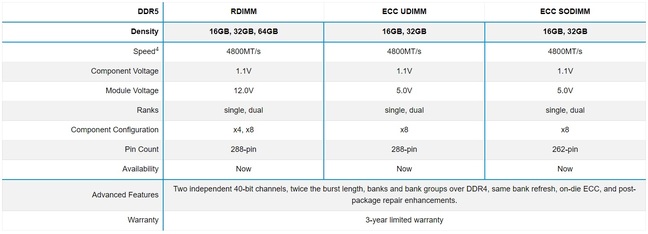Micron Releases DDR5 DRAM Ready For Next-gen Servers
Memory maker Micron has announced availability of DDR5 server DRAM components in preparation for server and workstation platforms from Intel and AMD that are due to support the faster memory standard.
Micron said its DDR5 server memory parts are now available through commercial and industrial channel partners in support of qualification for next-generation server and workstation systems based on Intel and AMD CPUs.
In other words, the memory chips are here, but the servers are not yet ready for them. Intel's Sapphire Rapids Xeon Scalable processor family will support the new memory standard, but Intel has repeatedly delayed this platform and volume production is not expected until later this year. AMD's Genoa, the first of its fourth-gen of Epyc server chips, is also expected to arrive in the fourth quarter of this year with support for DDR5.
DDR5 is already supported in newer CPUs aimed at desktop and laptop systems, even though it was suggested at the official publishing of the specifications that the enterprise and server markets would be the first to deploy the new memory in order to take advantage of its higher performance.
The first DDR server components feature a data rate of 4800MT/s, which delivers an estimated 1.87 times the bandwidth of DDR4 3200 modules, Micron said, but this is anticipated to increase in future iterations to offer even greater bandwidth.
- Micron aims 1.5TB microSD card at video surveillance market
- Micron dangles predictable memory price agreements in front of vendors
- Epyc move: Micron shifts high-demand chip design apps to AMD
- Micron expects COVID-19-hit Xi'an DRAM factory to reopen as normal soon
The memory maker also said that the first DDR5 server memory parts will come in modules up to 64GB, based on initial launch capacities manufactured using 16Gb die densities. The new standard also includes on-module power management capabilities.
Micron's VP and general manager for Commercial Products, Teresa Kelley, said that organizations need to maximize platform performance through the combination of the latest processors and advanced memory capabilities to keep pace with the growing volumes of data they face and the applications needed to process it all.
"Micron has been on the forefront of the industry's transition to DDR5 memory technology and is committed to empowering datacenter customers and channel partners in their server DDR5 DRAM qualification and readiness efforts," she said. ®
From Chip War To Cloud War: The Next Frontier In Global Tech Competition
The global chip war, characterized by intense competition among nations and corporations for supremacy in semiconductor ... Read more
The High Stakes Of Tech Regulation: Security Risks And Market Dynamics
The influence of tech giants in the global economy continues to grow, raising crucial questions about how to balance sec... Read more
The Tyranny Of Instagram Interiors: Why It's Time To Break Free From Algorithm-Driven Aesthetics
Instagram has become a dominant force in shaping interior design trends, offering a seemingly endless stream of inspirat... Read more
The Data Crunch In AI: Strategies For Sustainability
Exploring solutions to the imminent exhaustion of internet data for AI training.As the artificial intelligence (AI) indu... Read more
Google Abandons Four-Year Effort To Remove Cookies From Chrome Browser
After four years of dedicated effort, Google has decided to abandon its plan to remove third-party cookies from its Chro... Read more
LinkedIn Embraces AI And Gamification To Drive User Engagement And Revenue
In an effort to tackle slowing revenue growth and enhance user engagement, LinkedIn is turning to artificial intelligenc... Read more


